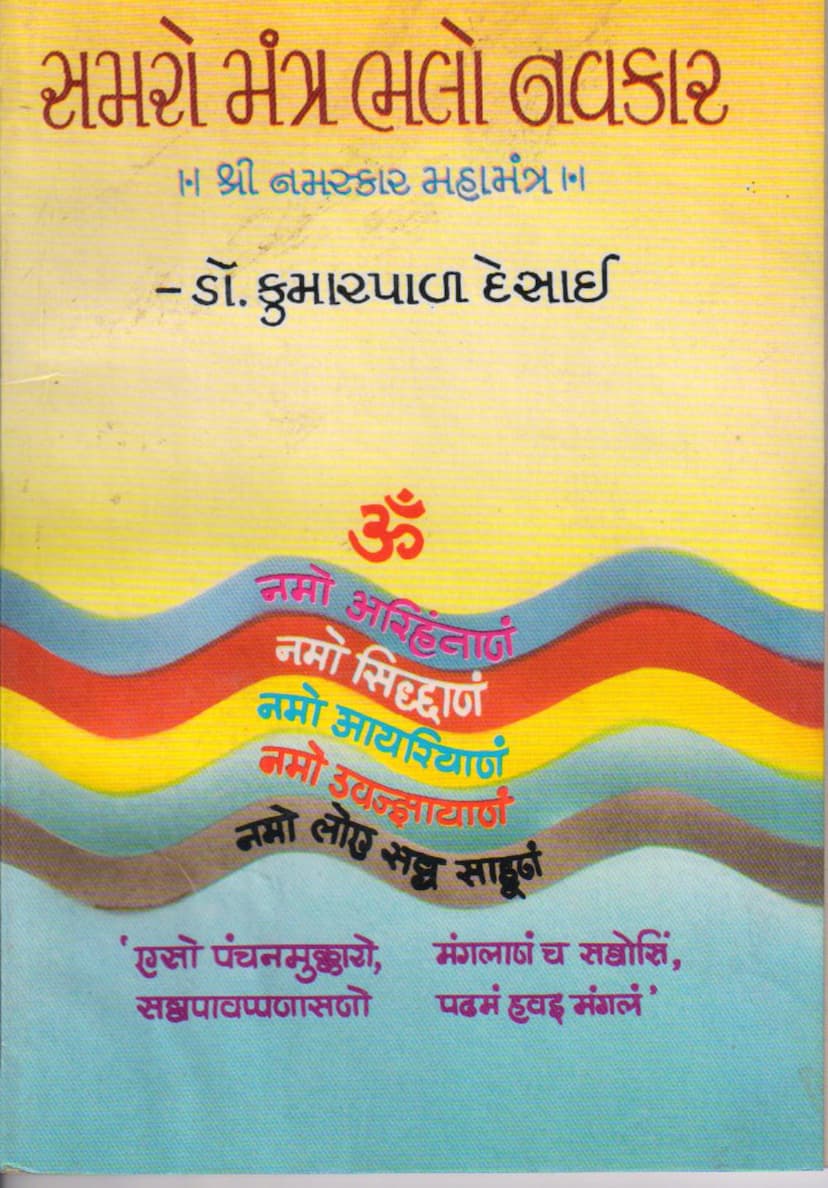Samaro Mantra Bhalo Navkar
Added to library: September 2, 2025

Summary
Here's a comprehensive summary of the Jain text "Samaro Mantra Bhalo Navkar" by Kumarpal Desai, based on the provided pages:
Book Title: Samaro Mantra Bhalo Navkar (Praise the Noble Navkar Mantra) Author: Kumarpal Desai Publisher: Jaibhikkhu Sahitya Trust
Overall Theme:
The book is an in-depth exploration and explanation of the Navkar Mahamantra, a foundational and sacred mantra in Jainism. The author aims to make this powerful mantra accessible and understandable to a wide audience, highlighting its philosophical depth, spiritual significance, and practical application in daily life.
Key Concepts and Content:
-
The Navkar Mahamantra:
- The mantra is introduced as a "Namaskar Mahamantra" composed of nine sacred syllables (Navkar).
- It is described as the essence of the fourteen Purvas (ancient Jain scriptures) and the heart of the Jain teachings.
- The mantra is characterized as a "svarup mantra" (mantra of inherent nature) rather than a sectarian mantra, focusing on qualities rather than individual worship.
- It is considered the primary auspiciousness among all auspicious things ("Manglanam cha sarvesham, prathamam havai mangalam").
-
The Five Supreme Beings (Panch Parmeshthi): The core of the mantra is the salutation to the Panch Parmeshthi, the five supreme souls in Jainism, who represent the highest ideals of spiritual attainment:
- Arihant: These are the souls who have conquered their inner enemies (kashayas - passion, anger, ego, greed, deceit) and achieved omniscience and omnipotence in a human body. They are the founders of the Jain faith and are characterized by their detachment (vitraag) and complete knowledge (sarvajna). The book emphasizes that Arihants are specifically those Tirthankaras who possess 34 auspicious attributes.
- Siddha: These are souls who have achieved liberation (moksha) by shedding all eight karmas (both destructive and non-destructive). They exist in a pure, bodiless state of eternal bliss and omniscience at the apex of the universe. The text clarifies that while individual souls achieve Siddhahood, the collective realm of Siddhas is considered "anadi-anant" (beginningless-endless).
- Acharya: These are the spiritual leaders who guide the monastic order (Sangha). They possess 36 specific virtues, including mastery of scriptures, adherence to vows, and the ability to lead and protect the spiritual path for both themselves and their disciples. Their role is crucial in preserving and propagating the Jain teachings.
- Upadhyay: These are learned monks who dedicate themselves to studying, teaching, and preserving the Jain scriptures. They are scholars and guides, responsible for imparting the knowledge of the scriptures to other monks and nuns. The text highlights their role in harmonizing knowledge (jnana) and practice (kriya).
- Sadhu: These are ascetics who have renounced the worldly life and practice vows of non-violence, truthfulness, non-stealing, celibacy, and non-possession. They are dedicated to self-realization and spiritual discipline, embodying detachment and equanimity. The book outlines different types of Sadhus, emphasizing the importance of "bhava-sadhu" (spiritual sadhu) over mere external appearance.
-
The Significance of Namaskar:
- The act of "namaskar" (salutation) itself is presented as a powerful spiritual practice that purifies the soul.
- It is believed to destroy all sins and obstacles, leading to spiritual progress.
- The mantra is described as a key to understanding the entire Jain philosophy.
-
The Structure and Meaning of the Mantra:
- The book breaks down the mantra, explaining the inherent meaning and spiritual import of each word and syllable.
- It clarifies that the first two words represent the divine (Dev), and the next three represent the spiritual preceptors (Guru), while the remaining four represent the righteous path (Dharma).
-
Qualities of the Panch Parmeshthi and the Ideal Practitioner:
- The text elaborates on the virtues and qualities that define each of the Panch Parmeshthi.
- It also implicitly outlines the qualities required of a practitioner who aims to emulate these ideals, emphasizing virtues like humility, detachment, knowledge, and right conduct.
-
The Author's Perspective and Purpose:
- Kumarpal Desai emphasizes the need for good reading and righteous thoughts in society.
- He expresses gratitude to the Karman Nondha family and Somchandbhai Shah for their support in publishing this book.
- The book is a compilation of articles originally published in the 'Mangalyaatra' magazine, indicating a positive reception.
- The author's goal is to present the Navkar Mahamantra in a simple language that is easily understandable to all devotees, addressing the curiosity of the faithful and clarifying deeper philosophical questions.
-
Deeper Philosophical Insights:
- Causality in the Universe: The text refutes the idea of an external creator (Ishwar) for the universe, stating that the universe and its transformations are self-created by the actions of living beings.
- The Nature of "Mangal": The book differentiates between "dravya-mangal" (material auspiciousness, like auspicious items used in rituals) and "bhava-mangal" (spiritual auspiciousness, like non-violence, self-control, and penance). It asserts that the Navkar Mahamantra is the ultimate "bhava-mangal" because it leads to the eternal and unwavering bliss of liberation.
- The Power of Renunciation (Diksha): The meaning of "Diksha" is explored, linking it to "Dana" (giving) and "Kshaya" (destruction), signifying the renunciation of worldly possessions and the shedding of karmas.
- The "Svarup Mantra": The mantra is presented as embodying the true nature (svarup) of existence and spiritual realization, rather than being tied to a specific sect or personality.
Overall Message:
"Samaro Mantra Bhalo Navkar" serves as a profound guide to the Navkar Mahamantra, encouraging readers to understand its deeper meaning and integrate its principles into their lives. It highlights the mantra's power to purify the soul, destroy sins, and ultimately lead to spiritual liberation, emphasizing the virtues of the Panch Parmeshthi as the highest ideals to strive for. The book is a testament to the enduring relevance and spiritual richness of Jain philosophy.